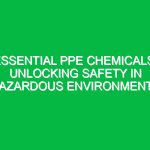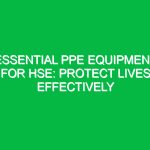Introduction
Good morning, team! Today, we are here for our Toolbox Talk, and the focus will be on a crucial aspect of our Health, Safety, and Environment (HSE) practices: Verifying Safeguards. This talk is essential not only for compliance with Regulations but also for ensuring that we all return home safely at the end of the day.
What Are Safeguards?
Before we dive into verifying these safeguards, let’s first clarify what we mean by “safeguards.” In the context of HSE, safeguards are measures or controls put in place to minimize risks and prevent accidents. They can include:
- Personal protective equipment (PPE)
- Safety protocols and Procedures
- Emergency response plans
- Equipment guarding systems
These safeguards are designed to protect us from various Hazards we might encounter in our daily operations.
The Importance of Verifying Safeguards
Now that we understand what safeguards are, let’s talk about why Verifying Safeguards is so critical. Simply having safeguards in place isn’t enough; we need to ensure they function effectively. Verifying safeguards helps us:
- Identify potential gaps in Safety Measures.
- Ensure compliance with legal and regulatory requirements.
- Promote a culture of Safety within the workplace.
- Enhance overall operational efficiency.
When we verify safeguards, we are actively participating in our Safety culture, demonstrating accountability, and reducing the likelihood of accidents. This process not only protects us but also our colleagues, clients, and the environment.
Key Aspects of Verifying Safeguards
Let’s take a closer look at the key aspects involved in verifying safeguards:
1. Regular Inspections
Regular inspections of equipment and Safety Measures are vital. This includes checking:
- Personal protective equipment for wear and tear.
- Safety barriers and guards for effectiveness.
- Emergency equipment, such as fire extinguishers and first aid kits.
Consider setting a schedule for these inspections and making it a routine part of our operations. For instance, if you’re using a ladder, check it for structural integrity before climbing.
2. Training and Awareness
Training is another crucial component of verifying safeguards. All employees must be well-informed about:
- The safety protocols in place.
- How to properly use protective equipment.
- The steps to take in case of an emergency.
Let’s share a quick example: last month, a team member noticed that a fire extinguisher was not functioning correctly. They raised the issue during our Toolbox Talk, and we replaced it immediately. This proactive approach can save lives.
3. Incident Reporting and Feedback
Encouraging open communication about safety incidents or near-misses is essential for verifying safeguards. If you see something unsafe, speak up! Reporting incidents allows us to:
- Identify weaknesses in our safeguards.
- Adjust protocols as necessary.
- Educate others to prevent future occurrences.
For example, if someone trips over equipment that isn’t properly stored, that’s a potential safety hazard we can address through better housekeeping practices.
4. Compliance with Regulations
It’s crucial to stay updated on HSE regulations and Standards relevant to our work. Compliance ensures that our safeguards meet legal requirements, which not only protects us but also minimizes legal risks for the company. Regularly review:
- OSHA (Occupational Safety and Health Administration) standards.
- Local regulations specific to our industry.
- Company policies on health and safety.
Being compliant is a shared responsibility, and it reflects our commitment to safety.
Best Practices for Verifying Safeguards
To ensure effective verification of safeguards, consider implementing the following Best Practices:
1. Develop a Verification Checklist
Create a checklist for verifying safeguards that can be used during inspections. This checklist should include all critical safety components and should be easily accessible to all employees.
2. Engage in Routine Safety Meetings
Regular safety meetings or Toolbox Talks should include discussions about the effectiveness of existing safeguards. This is a great opportunity for team members to share experiences and suggest improvements.
3. Foster a Safety Culture
Encourage a workplace culture that prioritizes safety. When employees feel empowered to speak up about safety concerns, it leads to better verification of safeguards and overall Workplace Safety.
4. Continuous Improvement
Always look for ways to improve safeguards. This might involve adopting new technologies, updating procedures, or enhancing Training programs. For instance, using digital safety management systems can streamline the verification process.
Real-Life Scenarios and Discussions
Let’s take a moment to discuss some hypothetical scenarios. Imagine you notice that a colleague isn’t wearing their PPE. What would you do? This is a perfect example of how verifying safeguards is not only about checks but also about actively ensuring that everyone adheres to safety protocols.
Another scenario could involve a piece of equipment that has been malfunctioning. If you report it immediately, we can take action before it leads to an incident. This proactive approach is vital for maintaining a safe work environment.
Summary of Regulations and Standards
As we wrap up our Toolbox Talk, let’s remember the importance of adhering to relevant regulations and standards. Compliance isn’t just about avoiding penalties; it significantly impacts our safety and legal obligations. Regularly review:
- osha regulations
- Local laws governing Workplace Safety
- Company-specific policies and guidelines
Staying informed keeps us all accountable and safe.
Conclusion
In conclusion, today we discussed the critical role of Verifying Safeguards in our daily operations. We covered the importance of regular inspections, training, incident reporting, and compliance with regulations. Remember, our safety is a shared responsibility, and your participation is crucial.
Thank you all for your attention and commitment to maintaining a safe working environment. Let’s continue to look out for one another and ensure that our safeguards are always verified and effective. Now, does anyone have questions or something they would like to discuss further?


